 East Asian ancestry % in Canada (2021) | |
| Total population | |
|---|---|
| 2,288,775[1][2][a][b] 6.3% of the total Canadian population (2021) | |
| Regions with significant populations | |
| Southern Ontario, Metro Vancouver, Central Alberta, Montreal | |
| Languages | |
| Canadian English · Canadian French · Mandarin · Cantonese · Korean · Japanese · Mongolian · Min Nan · Tibetan Other East Asian Languages | |
| Religion | |
| Buddhism · Chinese folk religion · Christianity · Confucianism · Shintoism · Taoism · Irreligion | |
| Related ethnic groups | |
| East Asian diaspora |


East Asian Canadians are Canadians who were either born in or can trace their ancestry to East Asia. East Asian Canadians are also a subgroup of Asian Canadians. According to Statistics Canada, East Asian Canadians are considered visible minorities and can be further divided by on the basis of both ethnicity and nationality, such as Chinese Canadian, Hong Kong Canadian, Japanese Canadian, Korean Canadian, Mongolian Canadian, Taiwanese Canadian, or Tibetan Canadian, as seen on demi-decadal census data.
According to the 2021 Canadian census, 2,288,775 Canadians had trace their ancestry to East Asia, constituting 6.3 percent of the total population and 31.2 percent of the total Asian Canadian population.[1][2][a][b] Additionally as of 2021, East Asians comprise the third largest pan-ethnic group in Canada after Europeans (69.8 percent)[3] and South Asians (7.1 percent).[2]
- ^ a b Cite error: The named reference
population2021Awas invoked but never defined (see the help page). - ^ a b c Cite error: The named reference
population2021Bwas invoked but never defined (see the help page). - ^ Government of Canada, Statistics Canada (2022-10-26). "The Canadian census: A rich portrait of the country's religious and ethnocultural diversity". www12.statcan.gc.ca. Retrieved 2022-01-10.
In 2021, just over 25 million people reported being White in the census, representing close to 70% of the total Canadian population. The vast majority reported being White only, while 2.4% also reported one or more other racialized groups.
Cite error: There are <ref group=lower-alpha> tags or {{efn}} templates on this page, but the references will not show without a {{reflist|group=lower-alpha}} template or {{notelist}} template (see the help page).